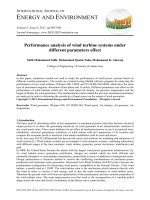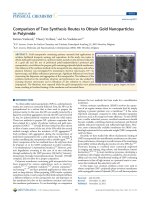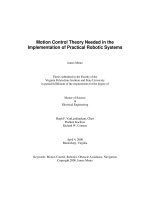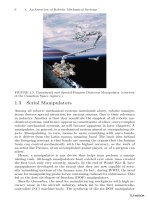Principles of Naval Weapon Systems Institute Blue & Gold Professional Library pptx
Bạn đang xem bản rút gọn của tài liệu. Xem và tải ngay bản đầy đủ của tài liệu tại đây (3.4 MB, 351 trang )
Principles of
Naval Weapons Systems
Edited by CDR Joseph Hall, USN
i
Introduction
In the early twentieth century, the instruments of war were simply called weapons.
The cannon, the rifle, or the bayonet were all considered separate pieces of weaponry to
be used in combat. By the Second World War, technology began to be integrated into
combat. The invention of radar and sonar extended the field of combat to greater and
greater ranges, and it was no longer necessary to sight targets directly. As technology
progressed, the very nature of weapons also changed. Now, it is no longer sufficient to
discuss individual pieces of weaponry, they must be taken in the context of the entire
weapons system, which is the complete set of interrelating pieces that function together to
achieve the goal of destroying a target.
The complete description of a weapons system must include all of the means of
exchanging information between sub-systems, called communication systems; all means
used to locate the target, called sensors; all means used to store, launch and deliver the
weapon to the target, called delivery sub-systems; and all means used to inflict damage
upon the target, called destruction sub-systems.
In this book, we will discuss how the various sub-systems function. The goal is to
understand the principles of operation of many different weapons systems. It is expected
that the reader will supplement this material with one of the many fine books describing
the arsenal of weapons currently in use by the major militaries of the world.
To understand how a complicated device such as a weapons system works, it is
often helpful to perform some level of abstraction first. In some ways, this is also how
weapons systems are designed. The abstraction is simply to ask “what are the inputs and
outputs?” This question can be applied at many different levels. To illustrate this concept,
consider the overall weapons system. The inputs come from the target and/or an operator.
The output is the destructive force that damages the target.
At the next level of abstraction, the roles of the major sub-sections can be
prescribed. The sensor sub-section takes the signals from the target and outputs the
location and direction of movement of the target to the delivery system. The delivery
system’s output is to put the weapon in close proximity to the target. Finally, given some
small separation from the weapon to the target, the destructive system outputs the
destructive force to the target. Of course, most of this is obvious. However, when this
method of breaking systems down into smaller functional sub-systems is applied to smaller
and smaller parts, it turns out to be a very useful way to understand how complicated
systems work. Once the roles of the various sub-systems are understood, then the details
of its operation can be put into context. This is the approach taken here.
1
Table of Contents
Chapter 1 _____________________________________________________________11
The Parameters of a Wave ___________________________________________________11
Traveling Waves ___________________________________________________________16
Frequency vs. Time Domain _________________________________________________17
Chapter 2 _____________________________________________________________21
Basic Phenomena___________________________________________________________21
Reflection ______________________________________________________________________23
Refraction ______________________________________________________________________24
Interference_____________________________________________________________________25
Diffraction______________________________________________________________________26
Antennas _________________________________________________________________ 27
The Dipole Antenna ______________________________________________________________27
Polarization_____________________________________________________________________28
Antenna Beam-forming ___________________________________________________________30
Modes of Propagation in Air _________________________________________________32
The Electromagnetic Spectrum _____________________________________________________32
Ground Waves __________________________________________________________________32
Sky Waves______________________________________________________________________33
Line of Sight ____________________________________________________________________36
Chapter 3 _____________________________________________________________39
Basic Components__________________________________________________________ 39
Transmitter _____________________________________________________________________40
The Transmission Channel_________________________________________________________40
The Receiver ____________________________________________________________________41
Modulation________________________________________________________________41
Noise_____________________________________________________________________42
Broadband (White) Noise __________________________________________________________42
Narrowband (Interference) Noise ____________________________________________________42
Chapter 4 _____________________________________________________________45
Amplitude Modulation (AM) _________________________________________________46
An AM system_____________________________________________________________ 48
The AM Spectrum__________________________________________________________49
Bandwidth______________________________________________________________________49
Efficiency ______________________________________________________________________51
2
Frequency Modulation (FM) _________________________________________________54
Bandwidth of FM __________________________________________________________55
Immunity to Static__________________________________________________________ 56
Phase Modulation (PM) _____________________________________________________56
Single Side-band (SSB)______________________________________________________ 57
Chapter 5 _____________________________________________________________61
The Binary Representation___________________________________________________62
The Binary number system_________________________________________________________62
Bits, bytes and words _____________________________________________________________64
Basic Components__________________________________________________________ 64
Central Processing Unit (CPU)______________________________________________________65
Bus ___________________________________________________________________________68
Memory________________________________________________________________________69
Input and Output (I/O) ____________________________________________________________71
Chapter 6 _____________________________________________________________73
Digital Data with Analog Signals ______________________________________________74
Amplitude Shift-Keying (ASK) _____________________________________________________74
Frequency Shift-Keying (FSK)______________________________________________________75
Phase Shift-Keying (PSK) _________________________________________________________75
M-ary Frequency/Phase Keying _____________________________________________________75
Amplitude-Phase Keying __________________________________________________________76
Capacity _______________________________________________________________________76
Minimum Shift Keying (MSK) _____________________________________________________77
Analog Data with Digital Signals ______________________________________________77
Sampling_______________________________________________________________________78
Encoding_______________________________________________________________________78
Digital - Digital ____________________________________________________________79
Parity Checksum_________________________________________________________________80
Chapter 7 _____________________________________________________________81
Multiplexing_______________________________________________________________81
Frequency Domain Multiplexing ____________________________________________________81
Time Domain Multiplexing ________________________________________________________82
Spread Spectrum Multiplexing______________________________________________________82
Local Area Networks (LAN) _________________________________________________ 83
Topology _______________________________________________________________________83
Protocols _______________________________________________________________________84
Wide Area Networks (WANs) ________________________________________________ 84
3
Fixed Wide Area Networks_________________________________________________________84
Cellular Networks________________________________________________________________85
Satellite Networks________________________________________________________________85
Chapter 8 _____________________________________________________________87
Principles of Operation______________________________________________________ 87
Mechanization _____________________________________________________________89
Radar performance _________________________________________________________95
Pulse Width_____________________________________________________________________95
Pulse Repetition Frequency (PRF) ___________________________________________________97
Radar Frequency_________________________________________________________________98
Theoretical Maximum Range Equation_________________________________________99
Chapter 9 ____________________________________________________________101
Principle of Operation______________________________________________________101
Frequency Modulated Continuous Wave (FMCW) radar _________________________104
Chapter 10 ___________________________________________________________109
Radial Velocity Discrimination_______________________________________________109
Differentiation__________________________________________________________________109
Moving Target Indicator (MTI) ____________________________________________________110
Pulse Doppler Radar_____________________________________________________________112
Limitations ____________________________________________________________________113
High Resolution Radar _____________________________________________________115
Pulse Compression ______________________________________________________________115
Synthetic Aperture Radar (SAR) ___________________________________________________116
Inverse Synthetic Aperture Radar (ISAR) ____________________________________________118
Phased Array Radar _______________________________________________________ 119
Chapter 11 ___________________________________________________________123
Radar Servo Tracking System _______________________________________________ 123
Range Tracking___________________________________________________________ 128
Track-While-Scan (TWS)___________________________________________________ 129
Phased-Array Tracking ____________________________________________________132
Tracking Networks ________________________________________________________133
Chapter 12 ___________________________________________________________135
The Electromagnetic Spectrum ______________________________________________ 135
4
Sources of Electro-Optical Radiation _________________________________________137
Thermal Radiators ______________________________________________________________137
Selective Radiators ______________________________________________________________141
Chapter 13 ___________________________________________________________145
Spreading________________________________________________________________146
Point Source ___________________________________________________________________146
Lambertian Source ______________________________________________________________147
Absorption/Scattering______________________________________________________148
Dependence of Attenuation on Wavelength __________________________________________149
Dependence of Attenuation on Range (Bouguer’s Law) _________________________________149
The Collected Flux ________________________________________________________ 151
Aperture ______________________________________________________________________151
Bandwidth Factor, F _____________________________________________________________152
Maximum Range Equation__________________________________________________ 154
Chapter 14 ___________________________________________________________157
The Field of View (FOV) ___________________________________________________157
Depth of Focus____________________________________________________________160
Scanning vs. Staring Sensors ________________________________________________ 161
Resolution _______________________________________________________________163
Spatial Resolution_______________________________________________________________163
Thermal Resolution _____________________________________________________________164
Spatial and Thermal Resolution, MRTD _____________________________________________164
Infrared Search and Tracking (IRST) Systems _________________________________166
Triangulation (passive)___________________________________________________________166
Laser range-finder (passive-active combination) _______________________________________167
Visible Band Imaging Systems ______________________________________________167
Magnification __________________________________________________________________167
Stadimeter Ranging _____________________________________________________________170
Light Amplification _____________________________________________________________171
Laser Target Illumination_________________________________________________________172
Chapter 15 ___________________________________________________________175
Acoustic Waves ___________________________________________________________176
Propagation Speed ______________________________________________________________177
Sound Pressure Level (SPL) _______________________________________________________178
Combining Sound Pressure Levels__________________________________________________179
Propagation Paths _________________________________________________________ 181
The Sound Velocity Profile (SVP) __________________________________________________181
5
Ray Tracing____________________________________________________________________184
Chapter 16 ___________________________________________________________191
Sources__________________________________________________________________191
Active Sonar ___________________________________________________________________191
Passive Sonar __________________________________________________________________192
Ambient Noise _________________________________________________________________193
Self-Noise _____________________________________________________________________196
Detection of Acoustic Energy ________________________________________________ 197
Beam-forming__________________________________________________________________197
Detection Criterion ______________________________________________________________198
Transmission Loss Formula _________________________________________________199
Range Effect ___________________________________________________________________199
Absorption/Scattering____________________________________________________________202
Other losses____________________________________________________________________203
Figure of Merit ___________________________________________________________204
Chapter 17 ___________________________________________________________209
Active Sonar _____________________________________________________________209
Transmitter ____________________________________________________________________209
Transducer Array _______________________________________________________________210
Beamforming Processor __________________________________________________________210
Duplexer ______________________________________________________________________211
Synchronizer___________________________________________________________________211
Receiver_______________________________________________________________________211
Display _______________________________________________________________________212
Passive Sonar Systems _____________________________________________________213
Hydrophone Array ______________________________________________________________213
Beamforming Processor __________________________________________________________214
Broadband Display ______________________________________________________________216
Frequency Analyzer _____________________________________________________________216
Narrowband Display_____________________________________________________________217
Variable Depth Sonar (VDS) ________________________________________________219
Towed Array Sonar Systems (TASS) _________________________________________219
Sonobuoys _______________________________________________________________221
Bistatic Sonar ____________________________________________________________ 222
Non-Acoustic Detection_____________________________________________________ 223
Visual ________________________________________________________________________223
Radar_________________________________________________________________________223
Infrared Detection_______________________________________________________________223
6
Magnetic Anomaly Detection (MAD) _______________________________________________224
Chapter 18 ___________________________________________________________225
Open and Closed Loop Systems______________________________________________ 225
The Transfer Function _____________________________________________________ 227
System Response __________________________________________________________ 229
Chapter 19 ___________________________________________________________233
Initial (Boost) Phase _______________________________________________________234
Mid-course Phase _________________________________________________________236
Terminal Phase ___________________________________________________________236
Chapter 20 ___________________________________________________________241
Global Positioning System __________________________________________________241
Principle of Operation____________________________________________________________241
System Components _____________________________________________________________244
Inertial Navigation Systems _________________________________________________ 246
Principle of Operation____________________________________________________________246
Chapter 21 ___________________________________________________________251
Interior Ballistics__________________________________________________________251
Propellant Types ________________________________________________________________252
Rifling________________________________________________________________________255
Exterior Ballistics _________________________________________________________257
Gravity _______________________________________________________________________257
Aerodynamic Forces _____________________________________________________________257
Aerodynamic Stability ___________________________________________________________258
Drift__________________________________________________________________________260
Coriolis Force __________________________________________________________________260
Aiming Errors ____________________________________________________________261
Chapter 22 ___________________________________________________________263
Explosive Reactions________________________________________________________ 263
Strength of Explosives______________________________________________________266
Categories of Explosives____________________________________________________ 268
Initiation of the Explosive Reaction ___________________________________________ 268
Chapter 23 ___________________________________________________________271
Warhead Construction _____________________________________________________ 271
7
Blast Effects______________________________________________________________272
Predicting Blast Effects_____________________________________________________ 274
Fragmentation Warheads ___________________________________________________ 276
Reduction in Velocity with Range __________________________________________________278
Chapter 24 ___________________________________________________________281
Warhead Reliability _______________________________________________________281
Probability of Kill (P
k
) _____________________________________________________ 284
Circular Error Probable____________________________________________________ 285
Levels of Damage _________________________________________________________ 285
Damage Criteria for Blast Effect Warheads ____________________________________286
Damage Criteria for Fragmentation Warheads _________________________________289
Personnel______________________________________________________________________289
Aircraft _______________________________________________________________________290
Armored Vehicles_______________________________________________________________290
Probable Number of Fragments Hitting the Target _____________________________________290
Chapter 25 ___________________________________________________________293
Armor-Piercing Warheads _________________________________________________293
Explosively Formed Penetrators (EFP)_______________________________________________293
Kinetic Energy Penetrators________________________________________________________295
Fuel-Air Explosive (FAE)___________________________________________________ 296
Incendiary Warheads ______________________________________________________ 296
Chapter 26 ___________________________________________________________297
Underwater Explosions_____________________________________________________ 297
Torpedoes _______________________________________________________________299
Sea Mines________________________________________________________________301
Mine Clearing ____________________________________________________________304
Chapter 27 ___________________________________________________________307
Principles of Operation_____________________________________________________ 307
The Difference Between Fission and Fusion Reactions __________________________________308
Mechanization of a Fission Warhead __________________________________________310
The simplest warhead design: gun-type _____________________________________________311
Improvements of fission warhead design _____________________________________________312
Mechanization of a Fusion Warhead __________________________________________313
8
Nuclear Weapons Safety__________________________________________________________314
Chapter 28 ___________________________________________________________317
The Blast Wave ___________________________________________________________ 317
Thermal Pulse ____________________________________________________________320
Nuclear Radiation _________________________________________________________321
Other Effects _____________________________________________________________322
Variation in Nuclear Explosion Effects by Burst Type ___________________________ 322
Air Burst ______________________________________________________________________322
High Altitude Burst______________________________________________________________322
Surface Burst___________________________________________________________________322
Underground Burst ______________________________________________________________323
Underwater Burst _______________________________________________________________323
Nuclear Attack Defensive Measures _________________________________________323
Sequence of Events ______________________________________________________________323
Defensive Measures: Priority of Actions _____________________________________________323
Chapter 29 ___________________________________________________________325
Types of Radiation ________________________________________________________326
Gamma _______________________________________________________________________326
Neutron _______________________________________________________________________326
Beta __________________________________________________________________________327
Alpha_________________________________________________________________________327
Measuring Radiation_______________________________________________________ 328
Units of measure ________________________________________________________________329
Somatic Effects ________________________________________________________________330
Sub-Clinical Dose, 0 to 100 rem____________________________________________________331
Therapeutic Dose, 100 to 1000 rem _________________________________________________331
Palliative Dose, > 1000 rem _______________________________________________________332
Probable Health Effects resulting from Exposure to Ionizing Radiation _____________332
Protection Standards_______________________________________________________ 333
Chapter 30 ___________________________________________________________341
Damage Criterion _________________________________________________________341
Diffraction Loading _____________________________________________________________341
Drag Loading __________________________________________________________________342
Fires/Burns ____________________________________________________________________342
Radiation______________________________________________________________________343
Predicting Nuclear Blast Effects______________________________________________ 343
9
Thermal Radiation Prediction _______________________________________________ 347
Radiation Dose Prediction __________________________________________________348
Chapter 1
Waves
11
Chapter 1
Waves
Figure 1-1. Energy for this wave comes form work done by the wind and gravity on the water offshore.
Basic to the process of communication is the ability to transmit or transfer
information. This transfer is accomplished by propagating waves of energy. Therefore, to
understand how communication systems work, we must first review the basics of waves.
The wave itself is some disturbance in a parameter that varies over its spatial dimensions.
The movement of the disturbance that maintains its shape (or changes slowly) is known as
propagation. The information that is to be exchanged is carried in one or more parameters
of the wave.
The Parameters of a Wave
If we were to take a “snapshot” image of a simple wave and capture its shape at a
particular instant in time, we could make a plot of the value, or amplitude, of the
disturbance as it varies over some distance.
Chapter 1
Waves
12
Distance
Value
1 2
Figure 1-2. Sine Wave.
In this example, the disturbance is periodic, meaning it repeats itself at regular
intervals. This is just a plot of the Sine function, y = Sin(x). Sometimes, this is called a
sine wave or sinusoidal wave. A wave need not be periodic or smoothly varying like the
sine wave, but as we will discuss later, the set of all sine waves forms a basis for the
description of any wave. So for now we will stay with sine waves, which have the
following parameters:
Wavelength: the distance between parts of the wave that repeat themselves. In our
example, the wavelength would be 1 unit on the horizontal axis. Wavelength is almost
always represented by the symbol λ (lambda).
Amplitude: the magnitude of the peak deviation from the average value of the
disturbance. In this case, the value of the disturbance is plotted as “y” on the vertical axis.
Since the wave varies about the value y=0, the amplitude is 0.5 units. You can also see
that this is one-half of the peak-to-peak difference. The units of amplitude depend on the
nature of the wave. A disturbance may be a physical displacement, like the height of the
water in an ocean wave. The disturbance may be an electric or magnetic field, in which
case they are called electromagnetic, or e-m waves. If the disturbance is a change in the
local pressure, the waves are called acoustic, or sound waves. In the following figure the
amplitude is labeled as “A.”
Chapter 1
Waves
13
Wavelength, λ
Amplitude, A
1
0.5
-0.5
Figure 1-3. The parts of a sine wave.
Figure 1-4. Phase difference between two waves.
There is one more parameter necessary to completely describe this wave, but
which cannot be readily understood from the current picture. Suppose we look at these
two waves with the same wavelength and amplitude. Although they have the same shape,
they differ in the starting point. This parameter is called the phase. For a single wave, it is
irrelevant because it corresponds to the arbitrary choice for the location of the horizontal
Chapter 1
Waves
14
axis. On the other hand, between two waves, the relative phase is important. For this
reason, we often discuss the phase difference or phase shift between two or more waves.
Although it should be clear what the significance of a phase shift is, it requires
some care to quantify it. First of all, because it is a difference agreement on the sign. In
this example, the second wave appears to be advanced, meaning it is further along in the
cycle than the first. To make the mathematics consistent, this should be a positive phase
shift. Another way to visualize this is to move the entire wave to the left for a positive
phase shift. This gets confusing for just about anyone, so it might be best to simply make
the following association:
positive phase shift ⇔ advanced wave
negative phase shift ⇔ retarded wave
As with any physical quantity, the phase shift must have units. We might be
tempted to use the same units as wavelength, but this would not be particularly useful.
What we really want to know, is the shift in the wave relative to the complete cycle.
Phase shift therefore has the units of an angle, because the sine wave is based on a circle
and repeats every 360
0
. This is a natural choice, since the argument of the sine function
must already have units of angle. So phase shift may vary between 0
0
and 360
0
. The
phase shift of 0
0
is no shift, and 360
0
corresponds to a shift of exactly one wavelength,
which is again equivalent to no shift at all. At 360
0
, we start over with 0
0
.
You might also note that a negative phase shift of -φ degrees is the same as the
positive phase shift of 360
0
-φ. These are just two equivalent ways to describe the
direction on a circle, one going counter-clockwise and the other clockwise.
Chapter 1
Waves
15
Figure 1-5. The equivalence of positive and negative phase shifts.
Finally, the units of phase are sometimes expressed in radians, which actually have no
units. To convert between degrees and radians you only need remember that there are 2π
radians in a 360
0
circle. So:
radians = (2π/360
0
) x degrees
degrees = (360
0
/2π) x radians
The conversion factor is about 57.3
0
per radian, or if you are in a hurry, ≈60
0
.
As we will see, the concept of phase shift is key to the operation of antennas and sonar
arrays. The last parameter of the sine wave is:
Phase: the angular argument (in degrees or radians) at which the sine wave begins, as
defined relative to some arbitrary starting point. The symbol for phase is either φ or θ.
Phase shift is sometimes represented by ∆φ or ∆θ (the Greek symbol ∆ , capital “delta,” is
used to denote change in a quantity).
− φ
360 - φ
Chapter 1
Waves
16
Traveling Waves
Up to this point, we have described the “snapshot” of a propagating wave at some
instant in time. Of course, the disturbance moves along at some speed. If you were to
travel along with the wave at that speed, you would see the same image as in the previous
description, although it might slowly change over time. However, if you were to remain
at a particular location and observe the wave, the disturbance would vary in time, identical
to the way it varied over distance in our “snapshot” view. Distance and time are related
by the speed of propagation, v. The wavelength now has an equivalent parameter,
corresponding to the interval of time between cycles, known as the period. The period is
often given the symbol T. A related parameter is the frequency.
Frequency: the number of complete cycles of a periodic wave that pass a stationary point
in one second. The frequency, f, is simply the inverse of the period, f = 1/T. Frequency
has units of Hertz (Hz), where 1 Hz = 1 cycle per second.
Since the wave is propagating with speed v, the frequency (or period) and
wavelength are related to one another. If the speed of propagation is independent of
wavelength of frequency, we have the following relationship:
fλ = c
This is also known as the dispersion relationship, because it describes how the speed of
propagation varies with frequency. For instance, a prism disperses light into separate
colors (frequencies) because they propagate at different speeds. Components with lower
speeds of propagation bend by a larger amount when they enter a new medium (this is
Snell’s law which is discussed in a later chapter). This causes the different frequency
components (colors) to be separated or dispersed.
prism
white (all colors) light
red
yellow
green
blue
Figure 1-6. How a prism disperses light.
Chapter 1
Waves
17
For electromagnetic (e-m) waves (light also being an electromagnetic wave) the speed of
propagation in space (or a perfect vacuum) is constant. Its velocity is the speed of light,
designated by the constant c, and has the following value for our purposes:
c = 3 x 10
8
m/s
The speed of light does not change greatly in most materials, especially air, and therefore
unless otherwise stated this value will also be used for the propagation of e-m waves in
air.
Frequency vs. Time Domain
When we plot the wave’s amplitude as a function of time (at a fixed location), we are
using the time domain description. This means nothing more than the fact that the
horizontal axis has units of time. The wave has parameters of amplitude and period
(disregard phase for now). As an alternate way to describe the very same wave, you only
need specify the amplitude and frequency. Clearly, these two descriptions are equivalent
for the simple sine wave we have been using as an example.
Now, real waves often have very complicated shapes (in the “snapshot” view). It
can be shown that most periodic waves can be constructed from a combinations of sine
and cosine waves with different frequencies. In order to construct the wave, one only need
know the relative amounts of each frequency component. In other words, the amounts of
each frequency are like a recipe card for constructing wave forms. The reverse operation
of finding the frequency components that make up a particular wave is called the spectral
decomposition or frequency analysis.
The description of a wave by specifying the value at points in time is the
representation in the time domain. If you specify the amount of each frequency
component (for sine and cosine waves), then the representation is in the frequency
domain. They should be thought of as two completely equivalent methods of representing
the same thing. Now, let’s look at a simple cosine wave in both representations.
Chapter 1
Waves
18
Signal amplitude (volts)
Time (seconds)
0 1
Power density (Watts/Hz)
Frequency (Hz)
TIME DOMAIN FREQUENCY DOMAIN
0 108
Figure 1-7. Time and Frequency Domain representation of cosine wave.
In the time domain, the cosine wave completes 8 cycles in 1 second. In the frequency
domain, we have a single component at 8 Hz.
The real value of the frequency domain will come with signals that appear
complicated in the time domain, but are simple combinations of sinusoidal waves.
Consider another example, but this time the signal is a simple combination of sine waves
but with different frequencies.
Signal amplitude (volts)
Time (seconds)
0 1
Power density (Watts/Hz)
Frequency (Hz)
TIME DOMAIN FREQUENCY DOMAIN
0 5010 20 30 40
2.7
1.2
0.3
1
2
1.5
2.5
0.5
Figure 1-8. A more complicated wave.
Chapter 1
Waves
19
The signal on the left appears slightly more complicated, and it would be difficult to
determine the nature of the signal. In the spectrum we see that it is a simple combination
of three frequency components. The strongest component is still at 8 Hz, with additional
contributions from 16 and 32 Hz. Because these higher frequencies are multiples of the
original frequency they are known as harmonics. The relative power levels are the square
of the relative contributions to the amplitude. In this case, the 16 Hz contribution is 1/3 as
large as original at 8 Hz. Likewise, the 32 Hz contribution is 2/3 as large. Here’s how
these numbers where obtained:
ratio of 8 Hz to 32 Hz = 2.7:1.2 = 2.25:1
square root of 2.25 = 1.5:1 or 3:2.
ratio of 8 Hz to 16 Hz = 2.7:0.3 = 9:1
square root of 9 = 3:1
The overall combination is therefore 3:1:2.
Chapter 2
Propagation of Waves
21
Chapter 2
Propagation of Waves
Figure 2-1. Communications satellite.
The process of communication involves the transmission of information from one
location to another using modulation to encode the information onto a carrier wave. It is
only the characteristics of the carrier wave that determine how the signal will propagate
over any significant distance. This chapter describes the different ways that
electromagnetic waves can propagate.
Basic Phenomena
An electromagnetic wave is created by a local disturbance in the electric and
magnetic fields. From its origin, the wave will propagate outwards in all directions. If the
medium in which it is propagating (air for example) is the same everywhere, the wave will
spread out uniformly in all directions, called a spherical wave.
Chapter 2
Propagation of Waves
22
Figure 2-2. Spherical wave.
Far from its origin, the wave will have spread out far enough that it will appear have the
same amplitude everywhere on the plane perpendicular to its direction of travel (in the
near vicinity of the observer). This type of wave is called a plane wave. A plane wave is
an idealization that allows one to think of the entire wave traveling in a single direction,
instead of spreading out like a spherical wave.
Figure 2-3. Plane wave.
Chapter 2
Propagation of Waves
23
Electromagnetic waves propagate at the speed of light. In a vacuum, the speed of
propagation is about 3 x 10
8
m/s. In other mediums, like air or glass, the speed of
propagation is slower. If the speed of light in a vacuum is given the symbol c, and its
speed in some medium is c
0
, we can define the index of refraction, n as:
n ≡ c/c
o
For most common mediums, as shown in Table 2-1, the index of refraction is greater than
one, meaning the speed of propagation is less than in vacuum.
substance index of refraction
vacuum 1
air 1.0003
water 1.33
glass 1.55
Table 2-1. Indices of refraction for common substances.
Reflection
When a plane wave encounters a change in medium, some, or all, of the wave may
propagate into the new medium and some may be reflected. The part that enters the new
medium is called the transmitted portion and the other the reflected portion. The part that
is reflected has a very simple rule governing its behavior, the angle of reflection = the
angle of incidence.
θ θ
I R
Figure 2-4. Reflection.









